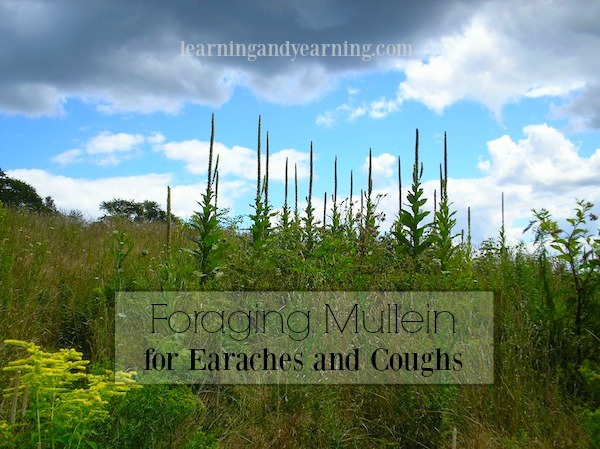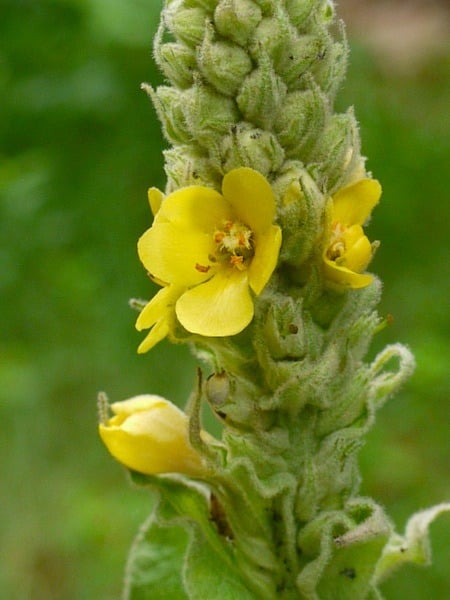
Home Medicine: Mullein for Earaches and Coughs
Common mullein, Verbascum thapsus, is a tall biennial that tolerates a wide range of growing conditions and is found throughout most of North America. As an herb, mullein is most commonly used to treat earaches and coughs, but has other uses as well.
Mullein prefers to grow in the sun and is often found along roadsides or open fields. In its first year of growth mullein will form a wooly rosette growing low to the ground. In its second year, it sends up a tall spike which then flowers. Once the flowers go to seed the plant withers and dies, the seeds are dispersed, and the cycle begins again.
Please keep in mind that I am not a health care professional, I’m just sharing some of the ways I use everyday herbs as home remedies for my family.
DISCLOSURE: In order for me to pay my blogging expenses, I may receive monetary compensation for my endorsement and/or link to products mentioned on this blog. I am a participant in the Amazon Services LLC Associates Program, an affiliate advertising program designed to provide a means to earn fees by linking to Amazon.com and affiliated sites.
Mullein’s alternate leaves have anti-spasmodic, expectorant, sedative and astringent properties which can be helpful in treating allergies, coughs, bronchial congestion and chest colds.

They may also be used as a poultice for boils, swollen glands, bruises and insect bites.
The pretty yellow flower with its 5 united sepals, 5 united petals, and 5 stamen can relieve pain and both prevent and fight infection. It is often used to fight mild to moderate ear infections. Keep in mind that it is not to be used to treat swimmer’s ear or any condition where water is in the ear. In these situations, it can make matters worse.
Mullein Oil for Earaches
Begin by harvesting about 1/4 cup of mullein flowers, just as they are opening. Allow the flowers to dry for about 24 hours at room temperature, or dry them in a dehydrator at low heat for an hour or two. Drying the herb helps to prevent mold from forming.
Place the dried flowers in a small mason jar and cover them completely with olive oil. Cover the jar and allow the flowers to infuse in the olive oil for about 2 weeks. For more information on infusing oils, and for ways to speed up the process, see this post.
Once infused, strain the flowers from the oil and bottle the mullein oil. Be sure to label the bottle with the contents and the date you made it.
To use: warm the oil over very low heat until just warm. Do not allow it to get hot. You may want to consider testing the oil in your own ear before placing any in a child’s ear to be sure the temperature is correct. You do not want the oil to be either cold or hot. Be sure to treat both ears since the infection can pass from ear to ear. Use 2 – 3 drops per ear, 2 – 3 times per day.

Mullein Leaves for Cough
When harvesting, be sure to choose healthy leaves. Dry the mullein leaves thoroughly. In a dehydrator this will take several hours at 125°F. They will dry more quickly if torn or cut into smaller pieces.
When dry, crumble them, and store in a zip-lock bag, or glass jar. Be sure to label and date the container.
To use: Place 1 Tablespoon of dried mullein in a tea strainer. Place in a cup and pour boiling water over the tea. Allow to steep for at least 10 minutes. Be sure the strainer you are using strains the tea completely since the small, hairy particles from the mullein leaf can irritate and actually cause coughing. You may want to consider making a tea bag from a coffee filter which does a great job of straining the tea. Sweeten with honey if desired.
Drink as often as needed until the cough subsides. If you are unable to find mullein leaf growing in your area, you can purchase it here.
For more information on medicinal teas, see this post.

Original article and pictures take learningandyearning.com site
Комментариев нет:
Отправить комментарий